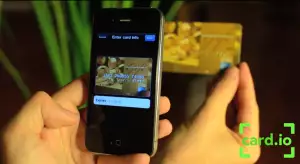It’s never easy predicting which technology will win out in a fast-growing and ever-changing sector crowded with players who are all touting their latest innovation as the future. And that’s especially true when it comes to working out exactly how people will eventually use their phones to pay when they shop. In this article, specially written for NetworkMilan, entrepreneur and social media strategist Danielle Dalkie considers the implications of PayPal’s ongoing tech spending spree. She also hovers her iPhone over the current state of QR codes and scanning technology to take a snapshot of developments in this rapidly-evolving market. Her conclusions may surprise you…
PayPal’s recent tie-up with Discover Card barely a month ago was yet another in a long line of strategic moves which show the growing importance of mobile as a payment option. Discover (which has just agreed to pay back $200m to millions of consumers who were charged for add-ons such as such as credit score tracking and identity theft protection), allows customers to access their PayPal account in-store by using their mobile phone number and PIN.) PayPal also snapped up credit card scanning service card.io earlier this year. However, while Paypal (which is owned by eBay) would like to think it is leading the mobile payments space their strategy so far seems to be more about acquiring interesting bits of technology to supplement online payments while trying to make it “mobile”. And let’s not forget Zong, another of their acquisitions last year, which also allows consumers to pay using their phone.

Card.io is just one of the many different mobile payments technologies PayPal is pinning its hopes on
Card.io provides mobile software that lets consumers use their smartphone cameras to scan credit cards for information, thereby simplifying the process of loading those cards into a digital wallet. Many mobile payment application developers have partnered with card.io to take advantage of its card scanning software, and according to PayPal’s Hill Ferguson those developers will continue to be given access to card.io’s technology.
Rather than backing one technology, PayPal is hedging its bets by backing various players. It’s also keen to head off competition by either controlling the technology used or matching it with something similar, if not indistinguishable, in all but name (and shape). PayPal’s Here, for example, allows merchants to accept a payment on any mobile phone using a detachable card-reader. The service presents a head-on challenge to Square, who have a virtually identical technology. The two systems are so close I think we will leave it to them to hash it out amongst themselves to see who wins this particular battle.
Early last year PayPal endorsed peer-to-peer NFC [Near Field Communication, which allows customers to pay by tapping or holding their phone near a counter-top device. Editor’s note.] Then came the big announcement towards the end of 2011 of their closed loop solution for the consumer, which seemed subsequently to have been completely refocused. Their agreement with Discover seems to complicate the picture even further.
PayPal’s NFC solution for mobile payments can hardly be called agile. Paying with your phone is supposed to be streamlined – so why would I want to have five different apps for my favourite stores? And then the scanner app as well? It’s clunky. This is where Google Wallet shows itself to be the true leader in the field. The NFC wallet is simple and really does cut down the time spent at the check-out. That said, the prospect of NFC as a universally-available function of the mobile phone is still a few years off. So we have two options: QR codes or tags? Whilst the code solution is much cheaper it is not that secure. The problem is that QR codes leaves users vulnerable to hackers who may use the code to lead them to a malicious website or application. And with less than 5 per cent of people having any form of security on their mobile phones, it potentially leaves them wide open to fraud.
This type of technology allows for closed loop solutions – a topic which I covered in a recent blog post here on NetworkMilan, explaining that this is good for merchants but makes it more complicated for the user. So, regular readers will already know I don’t think the current payments systems and solutions on offer are ideal. However, there does need to be a universal solution. The fact that your Google Wallet has Visa – which is accepted worldwide – is convenient. And until the industry can settle on an alternative, multiple closed loop solution, any challenger will always come second to the Visa and MasterCard network.
While scanner apps and barcodes are not without risks or issues, around 21 million American adults used mobile barcodes in 2011, a figure that grew by 147 per cent from the previous year, according to a survey carried out by eMarketer. This positive trend expected is expected to continue over the next few years and it tracks, of course, with the wider take-up of smartphones. (Around a quarter of smartphone owners use mobile barcodes, a figure which is set to continue rising, reaching nearly 40% by 2014). In this survey, consumers said they would use the technology to access discounts, offers or coupons, whereas only 23 per cent of respondents said they would want to use mobile barcodes to actually complete a purchase.
Since the number of consumers using the technology is growing, it makes sense that the Open Mobile Alliance (OMA) has developed a standard for handling 2D barcodes that it hopes will direct mobile phone users to websites more easily. By standardizing the specification for encoding, decoding and the resolution of 2D barcodes, the OMA has said it wants to stimulate the usage of the codes. Hopefully, standards like this will help to protect consumers and reduce the inherent security risks of these payment solutions. For the consumer, such an initiative can only be of benefit to them.
Ultimately, it really all comes downs to the basic economics of supply and demand. Consumers do want to be able to make mobile payments, but the technology we need to provide a universal, seamless and secure service is still a good few years off. I am not saying that QR Codes and scanners are not a great bit of technology; they are. However, it is just not a viable long-term solution.

QR codes for mobile payments? Consumers are not yet sold on the idea (Image: Frank Edens via Wikimedia Commons)
Online retail sales increased by 14% last year to more than £50bn, with predictions that the growth will continue to hit high streets, according to a new report. The increasing popularity of mobile devices, combined with the growth of mobile-based retail sites, is directly related and affected by the increase in online sales generally. Mobile really is the “missing link” between online and retail stores. It is going to be key, and business is fully aware of this. The challenge remains, however, to find a solution that is reliable not only in terms of technology and security, but one which also meets consumers’ increasingly important demands for services that don’t add unnecessary complication to their already busy lives.
Danielle Dalkie is the co-founder of Waspit, an innovative mobile payments service that provides social banking for students. She is based in Rome and works with clients based in Italy, the UK and the US. Danielle has recently founded Network Roma, a LinkedIn group dedicated to facilitating networking opportunities and collaboration among freelancers and companies with a Roman connection.
Still confused by the plethora of mobile payment technologies out there? Check out The Most Important Mobile Payment Infographic Ever created by MobilePaymentsToday.com.








